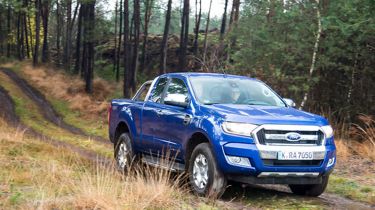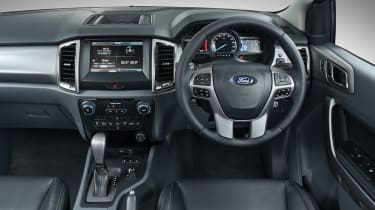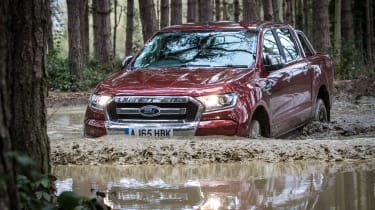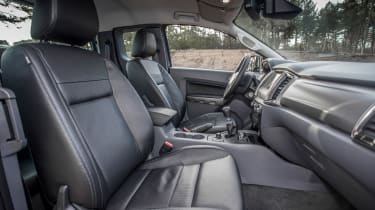New Ford Ranger 2016 review
Facelifted Ford Ranger gets interior and tech upgrades to compete with a host of rivals

Ford has brought a package of much-needed improvements to the Ranger pick-up to help it keep pace with a growing band of rivals. In general, the upgrades have been a success with Ford’s truck now bristling with technology and safety kit. The Ranger is also a great workhorse, adept off-road with big load-carrying potential, but it’s let down by engines that are behind the curve on refinement and fuel economy.
Have you got a jet ski in the garage or a landscape gardening business? If so, 2016 is shaping up to be a vintage year. Not because global warming is extending the growing season or making UK sea temperatures that bit more bearable, because we’re being inundated with new pick-up trucks!
The Ford Ranger is the latest to land, a mid-life facelift of the truck Ford launched in 2011. It goes straight into battle against the new Mitsubishi L200 and Nissan Navara that we tested head-to-head recently, while we wait for the arrival of the new Toyota HiLux and the facelifted Volkswagen Amarok.
• Best pick-up trucks to buy now
Beyond those familiar names, pick-up newcomers like the Renault Alaskan and Fiat Fullback are due before the year is out. Even Mercedes-Benz has a pick-up in the pipeline so people who tow, off-road and/or need a tough utility vehicle for work have a wealth of options at their disposal.
It all means that the Ford Ranger will have a tough task holding on to the European pick-up market number one spot that it achieved for the first time in 2015, selling over 8,000 units. But in a bid to keep rivals at bay, Ford has modernised the styling inside and out, adding a clutch of the latest technology and safety features. Engineers also moved to improve the driving experience with engine and suspension upgrades.
Used - available now

2023 Land Rover
Range Rover Evoque
18,682 milesAutomaticDiesel2.0L
Cash £33,995
2019 BMW
1 Series
48,573 milesAutomaticPetrol1.5L
Cash £13,987
2017 Ford
Fiesta
38,600 milesManualPetrol1.2L
Cash £6,100
2016 Tesla
Model S
78,000 milesAutomaticElectric
Cash £18,999Has any of it worked? Well, the Ranger looks the part with its new grille echoing the shape of the ones found on the latest Ford passenger cars and integrating with the new slimmed down headlights on each side. The interior has been successfully spruced too with lots of passenger car switchgear and a new 8” touchscreen with Ford’s SYNC2 technology for the higher spec versions.
The usual word of warning with any pick-up range applies in that the top-spec versions are substantially more luxurious than the utilitarian entry-level models. The Ranger range runs from XL to XLT, Limited and Wildtrak and it’s only the two latter versions that get the 8” touchscreen. The others also do without the more upmarket trim finishes to keep costs down and better stand up to kind of tough use that owners tend to dish out.
Ford builds single cab, Super Cab and Double Cab versions of the Ranger with the most popular Double Cab bodystyle offering four doors and five seats to the Super Cab’s suicide back doors and occasional rear seating. You can seat five at a squeeze too, with the Double Cab having just enough legroom for a 6ft adult to sit behind a 6ft driver. Headroom is OK in the back, so longer journeys with four on board are not out of the question.
All of which brings us to the Ford Ranger’s road-going performance, which has improved with the revised suspension and the arrival of electric power steering. The steering makes a big positive impact on the way the Ranger drives with enough weight and precision to give confidence at speed but a lighter feel for easier low speed manoeuvring and off-road driving.
The ride is best described as choppy but the Ranger manages to resist rolling around too much in corners and stays composed over all but the most sudden undulations. For comfort, it’s not comparable with today’s large SUVs but those used to rough ‘n’ ready road manners of a pick-up won’t find anything amiss.
Two engines are offered; a 2.2-litre TDCi 4-cylinder diesel with 158bhp and a 3.2-litre 5-cylinder TDCi unit with 197bhp. The latter is the biggest hitting engine in the UK pick-up class at the moment but where it feels strong on the road (particularly from low revs), refinement is an issue. The engine is OK at idle but noisy when revved and doesn’t settle down much at higher speeds where there’s also a fair bit of wind noise. The 2.2-litre unit is quieter and smoother with performance that’s only a shade inferior in normal driving, so it would be our pick.
Although efficiency improvements have been made, including the addition of start-stop on most models, neither of the Ranger’s engines covers itself in glory when it comes to fuel economy. The 2.2-litre can return up to 43.5mpg on the combined cycle, giving CO2 emissions of 171g/km, but that’s still not quite up to what the best rivals can muster. The 6-speed automatic gearbox shifts smoothly but blunts economy to 35.3mpg (209g/km of CO2), which is further down on equivalent versions of the L200 and Navara.
Ford offers a rear-wheel drive version of the Ranger but the vast majority will have the full electronically controlled 4x4 set-up that lets you switch from two to four-wheel drive on the move or engage low-range 4x4 mode for proper off-roading. It feels very at home in the mud with a class-leading wading depth of 800mm, hill descent control and an optional locking differential making it quite the off-road tool.
The Ranger is also extremely capable in heavy-duty use on the road with the Double Cab offering a 1,199kg payload and a class-leading 3,500kg maximum towing weight. Ford’s added a load of advanced safety equipment too, including a stability control system with trailer sway control to keep that jet ski in check. The Driver Assistance Pack might be £1,350 but its adds lane keeping assist, traffic sign recognition, automatic high-beam head lights, adaptive cruise control and collision mitigation to make your truck feel a bit like a luxury saloon.












